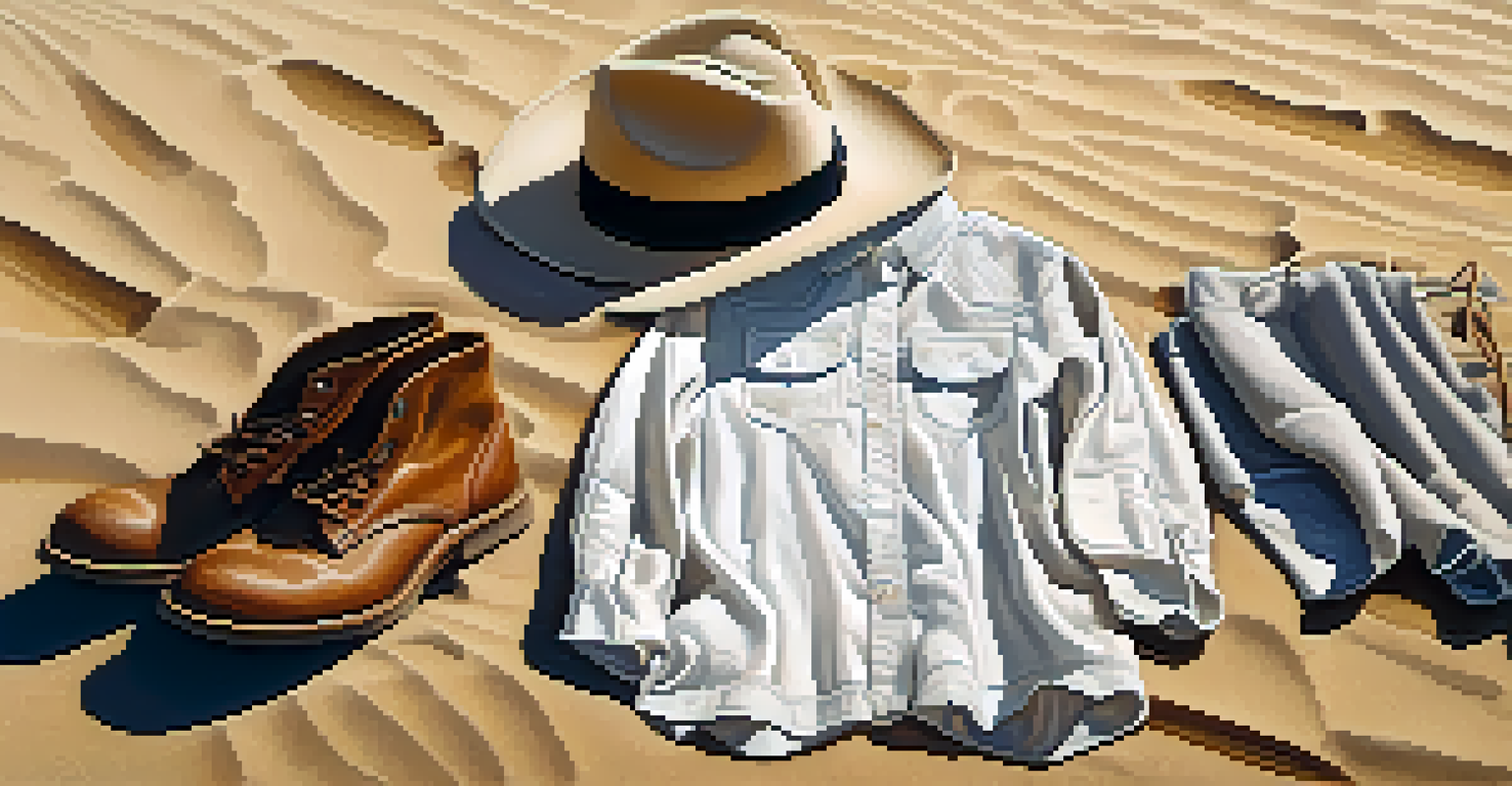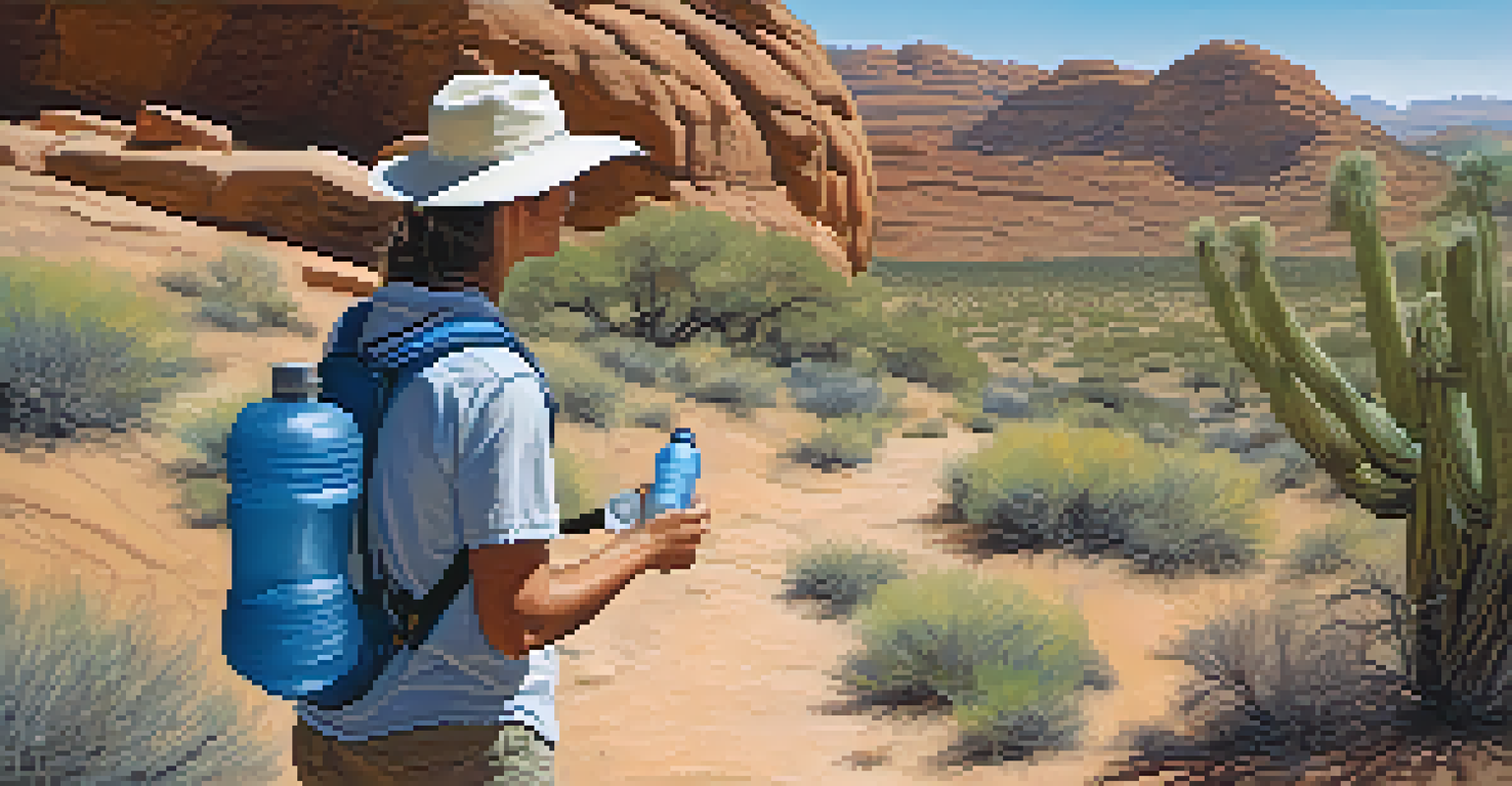Packing for Desert Climates: Stay Cool and Prepared

Understanding Desert Climate: Key Characteristics
Desert climates are known for their extreme temperatures, with scorching hot days and surprisingly cool nights. Understanding this unique climate is essential for effective packing. The stark contrast in temperatures means you need to be prepared for both heat and coolness, especially after sunset.
In every walk with nature one receives far more than he seeks.
Additionally, desert areas often have low humidity, which can lead to rapid dehydration. It’s important to consider this when choosing what to bring. Packing items that help you stay hydrated and protected from the sun is crucial for a comfortable experience.
Lastly, deserts can be windy, which might cause dust storms or sand exposure. Being aware of these conditions helps you select the right gear, ensuring you’re well-prepared for whatever the desert throws your way.
Choosing the Right Clothing for Comfort
When it comes to desert packing, clothing is key. Opt for lightweight, breathable fabrics like cotton or linen that allow air to circulate. Loose-fitting clothes help to keep you cool and protect your skin from the harsh sun, which is especially important during peak hours.

Consider wearing light-colored clothing, as it reflects sunlight rather than absorbing it. Dark colors can make you feel hotter, so aim for whites, beiges, or pastels. A wide-brimmed hat is also a great addition, providing shade for your face and neck.
Respect the Desert Environment
Following local guidelines and practicing Leave No Trace principles helps preserve the delicate desert ecosystem for future generations.
Don't forget about layering! While days can be sweltering, temperatures can drop significantly at night. A light jacket or sweater is a smart choice to ensure you stay comfortable after sunset.
Hydration Essentials: Staying Cool and Hydrated
Staying hydrated in the desert is non-negotiable. The dry air and intense heat can quickly lead to dehydration, so always carry water with you. A reusable water bottle or hydration pack is a great way to ensure you have constant access to water.
The desert tells a different story every time one ventures on it.
Consider packing electrolyte tablets or sports drinks as well. These can help replenish vital minerals lost through sweat, making it easier to stay energized and avoid fatigue. Remember, drinking water is important, but maintaining your electrolyte balance is just as crucial.
To make staying hydrated easier, set reminders on your phone to drink water regularly. This small habit can make a big difference in how you feel throughout the day, especially when exploring the vast desert landscape.
Essential Gear: Tools for Desert Exploration
Packing the right gear can elevate your desert adventure from ordinary to extraordinary. A sturdy pair of hiking boots is essential if you plan to explore rugged terrain. Look for shoes that offer good grip and support, as the ground can be uneven and rocky.
Don't forget about sun protection! Sunscreen with high SPF, sunglasses, and lip balm are must-haves to shield your skin from harmful UV rays. Apply sunscreen generously, even on cloudy days, since sunlight can still penetrate through the clouds.
Prepare for Temperature Swings
Desert climates feature extreme temperature variations, so packing for both heat and cool nights is essential.
A reliable map or GPS device is also crucial. Cell service may be spotty in remote desert areas, so having a physical map or a downloaded offline map can keep you on track and safe during your adventures.
Food Packing Tips: Nutrition for Hot Climates
When packing food for desert excursions, focus on lightweight, non-perishable options. Trail mix, energy bars, and dried fruits are excellent choices as they provide energy without weighing you down. These snacks are easy to carry and can keep your energy levels stable.
Avoid packing heavy or perishable items that might spoil in the heat. Instead, consider meals that can be eaten at room temperature, such as wraps or salads. These can be refreshing and satisfying during a hot day.
Remember to keep food in airtight containers to prevent contamination from dust. This simple step can make a world of difference in maintaining food quality while you enjoy your desert adventure.
Navigating Desert Wildlife: Precautions to Take
Deserts are home to unique wildlife, including snakes, lizards, and various insects. While these creatures are generally not aggressive, it’s wise to be aware of your surroundings. Wearing sturdy boots and long pants can help protect you from unexpected encounters.
Consider carrying a small first-aid kit that includes items to treat insect bites or minor injuries. Being prepared can give you peace of mind during your outdoor adventures. Plus, it’s always better to be safe than sorry!
Stay Hydrated and Nourished
Carrying enough water and lightweight, non-perishable snacks is crucial to avoid dehydration and maintain energy.
If you plan to camp, set up your site away from dense shrubbery where animals might hide. Additionally, store food securely to avoid attracting wildlife. Following these precautions will ensure a safe and enjoyable experience in the desert.
Understanding Desert Etiquette: Respecting the Environment
When exploring the desert, it's crucial to respect the environment and follow local guidelines. Stay on marked trails to protect delicate vegetation and prevent erosion. This not only preserves the natural beauty but also ensures safety during your hikes.
Take your trash with you—this is a simple way to keep the desert pristine for future visitors. Consider participating in local clean-up efforts if you have the time. It’s a great way to give back to the environment that gives us so much joy.

Finally, be mindful of noise levels. Many desert areas are home to sensitive wildlife and tranquil landscapes. Keeping the noise down allows everyone to enjoy the serene beauty of the desert without disturbing its inhabitants.